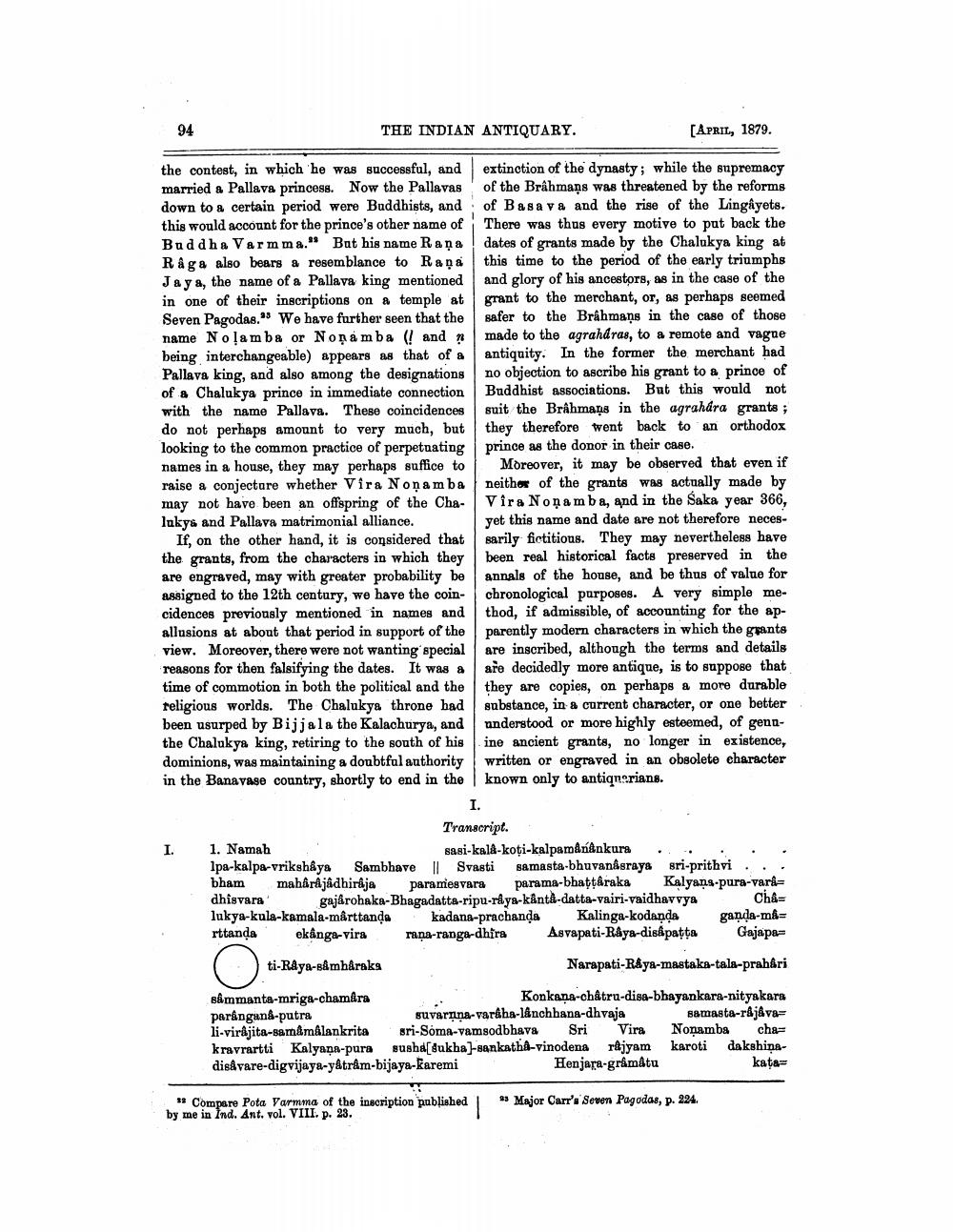________________
94
THE INDIAN ANTIQUARY.
[APRIL, 1879.
the contest, in which he was successful, and extinction of the dynasty; while the supremacy married a Pallava princess. Now the Pallavas of the Brahmans was threatened by the reforms down to a certain period were Buddhists, and of Basa va and the rise of the Lingayets. this would account for the prince's other name of There was thus every motive to put back the Buddha Varmma." But his name Rana dates of grants made by the Chalukya king at Råga also bears & resemblance to Rapa this time to the period of the early triumphs Jaya, the name of a Pallava king mentioned and glory of his ancestors, as in the case of the in one of their inscriptions on a temple at grant to the merchant, or, as perhaps seemed Seven Pagodas." We have further seen that the safer to the Brahmans in the case of those name Noļamba or Noņámba (? and ? made to the agrahdras, to a remote and vague being interchangeable) appears as that of a antiquity. In the former the merchant had Pallava king, and also among the designations no objection to ascribe his grant to a prince of of a Chalukya prince in immediate connection Buddhist associations. But this would not with the name Pallava. These coincidences suit the Brahmans in the agrahara grants ; do not perhaps amount to very much, but they therefore went back to an orthodox looking to the common practice of perpetuating prince as the donor in their case. names in a house, they may perhaps suffice to Moreover, it may be observed that even if raise a conjecture whether Vira Noņamba neither of the grants was actually made by may not have been an offspring of the Cha- Vira Noņamba, and in the Saka year 366, lukys and Pallava matrimonial alliance. yet this name and date are not therefore neces
If, on the other hand, it is considered that sarily fictitious. They may nevertheless have the grants, from the characters in which they been real historical facts preserved in the are engraved, may with greater probability be annals of the house, and be thus of value for assigned to the 12th century, we have the coin- chronological purposes. A. very simple mecidences previously mentioned in names and | thod, if admissible, of accounting for the apallusions at about that period in support of the parently modern characters in which the grants view. Moreover, there were not wanting special are inscribed, although the terms and details reasons for then falsifying the dates. It was a are decidedly more antique, is to suppose that time of commotion in both the political and the they are copies, on perhaps a more durable religious worlds. The Chalukya throne had substance, in a current character, or one better been usurped by Bijjala the Kalachurya, and understood or more highly esteemed, of gendthe Chalukya king, retiring to the south of his ine ancient grants, no longer in existence, dominions, was maintaining a doubtful authority written or engraved in an obsolete character in the Banayage country, shortly to end in the known only to antiqnorians.
I.
Transcript. 1. Namah
sasi-kala-koti-kalpamânankura . 1pa-kalpa-vrikshâys Sambhave | Svasti samasta-bhuvanâsraya sri-prithvi ... bham maharajadhiraja paramiesvara parama-bhattâraka Kalyans-pura-varidhisvara g ajarohaka-Bhagadatta-ripu-raya-kanta-datta-vairi-vaid havvya Cha= lukya-kula-kamala-mårttanda kadana-prachanda Kalinga-kodanda ganda-ma= rttanda ekânga-vira rana-ranga-dhira Asvapati-Raya-dis&patta Gajapati-Raya-Bâmháraks
Narapati-R&ya-mastaka-tals-prahari sammanta-mriga-chamara
Konkana-châtru-disa-bhayankara-nityakara paranguna-putra
suvarnna-varha-lânchhana-dhvaja samasta-r&jáva= li-virajita-samamalankrita Bri-Soma-vamsodbhava Sri Vira Noņamba chakravrartti Kalyana-pura susha dukha)-sankatha-vinodena rajyam karoti dakshinadisAvare-digvijaya-yatram-bijaya-karemi
Henjara-gråmátu
kata
* Compare Pota Varmma of the inscription published by me in Ind. Ant. vol. VIII. p. 23.
Major Carr's Seven Pagodas, p. 224.




